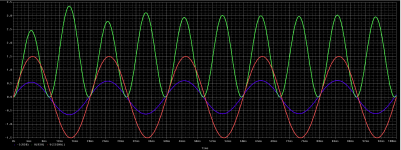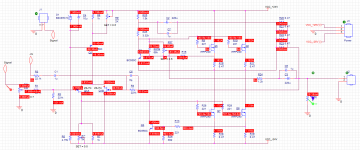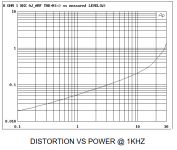Hello to the community. I’m new to electronics and amps in particular. Couple of questions bother me while choosing the project to build (amp+ diy speakers):
1. Which of SE amp operates great with low impedance speakers?
2. Could some one explain the principle of operation of aleph 3 for example as i intended to build this one for me (initially i was planning to build high-sensitivity speakers). This would be of a great help to me
1. Which of SE amp operates great with low impedance speakers?
2. Could some one explain the principle of operation of aleph 3 for example as i intended to build this one for me (initially i was planning to build high-sensitivity speakers). This would be of a great help to me
Really, SE amps are not usually the best choice for low impedance unless
they have been designed for them, and usually they are not.
If you can tell us the impedance and maybe the efficiency of the speaker
we might be able to have more advice.
The Aleph 3 is a simple amplifier, and not hard to understand. The Zen
amplifiers are similar, and you will find a series of articles at
FIRST WATT
The articles were written so as to explain the operation clearly, and I think
you will find them helpful.

they have been designed for them, and usually they are not.
If you can tell us the impedance and maybe the efficiency of the speaker
we might be able to have more advice.
The Aleph 3 is a simple amplifier, and not hard to understand. The Zen
amplifiers are similar, and you will find a series of articles at
FIRST WATT
The articles were written so as to explain the operation clearly, and I think
you will find them helpful.

Thank you mr. Pass. I really really appreciate your attention to my research. I’m planing to build either Troel’s tqwrt with approx 95 dB or speakers in a range of 90-95 dB, impedance: 4-6 ohm as major linear value with peaks at 25-30 ohms. I prefer listening to music quietly (similar to normal speech in 20 sq meters room). That is the reason i’m confused at this point-whether given power of 30w (aleph 3, aleph j) will be sufficient to this sensitivity range. Unfortunately i did never see frequency dependance on distortion for speakers unlike your manuals where it is clearly stated -the less power we output the less distortion we will have.
Last edited:
I’ve already done schematics with simulations as well as pcb for aleph 3 and aleph j for studying and building purposes,
but could not quite understand the principle. I’ll study your material in details.
One more question-what is the minimum impedance and sensitivity to be operated by these amplifiers concerning my initial data?
but could not quite understand the principle. I’ll study your material in details.
One more question-what is the minimum impedance and sensitivity to be operated by these amplifiers concerning my initial data?
Last edited:
If you can tell us the impedance

Another noob question: Is the speaker's minimum impedance the relevant number? I mean in this case and in general when matching speakers with amp. Oh.. I imagine dips in impedance will not be as important in those parts of frequenzyspektum where music dont contain much energy?
An Aleph 3 or Aleph J will easily have the ability to play the 95dB DTQWT to levels that will be louder than you would want to listen to long term.
Most people are very surprised at the listening levels afforded them by these amplifiers even when their speaker sensitivity is much, much less.
Please start your project! We'll be happy to help.
Most people are very surprised at the listening levels afforded them by these amplifiers even when their speaker sensitivity is much, much less.
Please start your project! We'll be happy to help.

Please correct me if i’m wrong in my estimation.
Initial data
Desired SPL (dB) = 75
Distance to listener, l = 3 m
Speaker sensitivity, Е0 = 87 dB
Minimal linear impedance of speakers, R = 4 Ohm
Lets estimate the required amp’s power output
1. SPL = E0 + 10lg(P) - 20lg(l)
2. SPL loss due to specified distance 20*LOG10(3) = 9,5 dB
3. Let’s estimate the output power for the desired SPL. For simplicity instead of RMS lets take the peak output power: P= 3 W-> SPLDB = E0 + 10lg(P) - 20lg(l) = 80,7 dB
4. Output current: P=I^2/R -> I = SQRT (P/R) = SQRT (3/4) = 0,87 А
5. Sin input wave simulation results: output current (blue), output power (green) and input voltage wave (red)
Next step-checking node currents for transistors. Seems to be ok.
Graph THD on power for Aleph j tells us that we are in 0.1% of THD with 3W of output power.
So, to conclude the amp is capable to perform good with the initial data???
Initial data
Desired SPL (dB) = 75
Distance to listener, l = 3 m
Speaker sensitivity, Е0 = 87 dB
Minimal linear impedance of speakers, R = 4 Ohm
Lets estimate the required amp’s power output
1. SPL = E0 + 10lg(P) - 20lg(l)
2. SPL loss due to specified distance 20*LOG10(3) = 9,5 dB
3. Let’s estimate the output power for the desired SPL. For simplicity instead of RMS lets take the peak output power: P= 3 W-> SPLDB = E0 + 10lg(P) - 20lg(l) = 80,7 dB
4. Output current: P=I^2/R -> I = SQRT (P/R) = SQRT (3/4) = 0,87 А
5. Sin input wave simulation results: output current (blue), output power (green) and input voltage wave (red)
Next step-checking node currents for transistors. Seems to be ok.
Graph THD on power for Aleph j tells us that we are in 0.1% of THD with 3W of output power.
So, to conclude the amp is capable to perform good with the initial data???
Attachments
Is the speaker's minimum impedance the relevant number? I mean in this case and in general when matching speakers with amp. Oh.. I imagine dips in impedance will not be as important in those parts of frequency spectrum where music don't contain much energy?
It is one of several numbers. If it really dips down below 4 ohms you hope
that it's in an area where there isn't that much musical energy.
Good example is electrostatic loudspeakers, which often go down to
1 ohm or below at high frequencies, 10 KHz or higher, but still seem to
work OK with amps that otherwise are not rated for that impedance.
- Status
- This old topic is closed. If you want to reopen this topic, contact a moderator using the "Report Post" button.
- Home
- Amplifiers
- Pass Labs
- Couple of noob questions regarding amps


